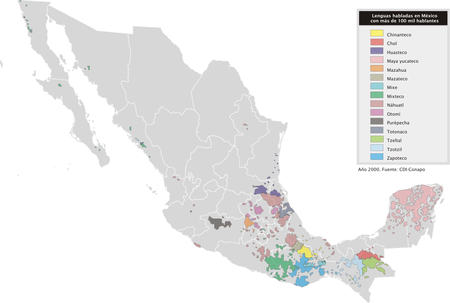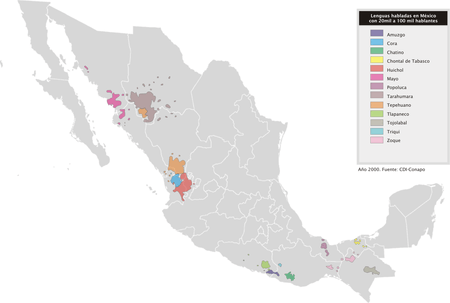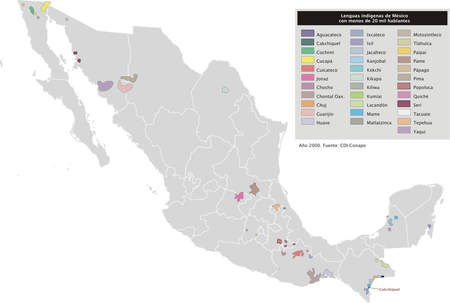Languages of Mexico
| Languages of Mexico | |
|---|---|
| Official languages | None at federal level |
| Main languages | Mexican |
| Minority languages | Catalan, Plautdietsch, Chipilo Venetian dialect |
| Main immigrant languages | English |
| Main foreign languages | German, Greek, Italian, Arabic, French, Portuguese, Chinese, Japanese, English |
| Sign languages |
Mexican Sign Language Yucatan Sign Language Plains Sign Talk American Sign Language |
| Common keyboard layouts |
 |
Several different languages are spoken in Mexico, with a large majority of the population fluent in Spanish while some indigenous Mexicans are monolingual in indigenous languages. Most Mexicans are monolingual Spanish-speakers.
The government of Mexico uses Spanish for most official purposes, but in terms of legislation its status is not that of an official language. The Law of Linguistic Rights establishes Spanish as one of the country's national languages, along with 68 distinct indigenous languages (from seven different families, and other four isolated languages). The law, promulgated in 2003, requires the state to offer all of its services to its indigenous citizens in their mother tongues, but in practice this is not yet the case. Due to the long history of marginalization of indigenous groups, most indigenous languages are endangered, with some languages expected to become extinct within years or decades, and others simply having populations that grow slower than the national average. According to the Commission for the Development of Indigenous Peoples (CDI) and National Institute of Indigenous Languages (INALI), while 10–14% of the population identifies as belonging to an indigenous group, around 6% speak an indigenous language.
There are other languages not native to Mexico that are spoken in the country, the most common being English.
Language history

The slow process of replacing Mexico's indigenous languages with Spanish began with the arrival of Spanish forces and colonists in Mexico in the 16th century. Some monks and priests attempted to describe and classify indigenous languages with Spanish. Philip II of Spain decreed in 1570 that Nahuatl become the official language of the colonies of New Spain in order to facilitate communication between the natives of the colonies.[1]
In 1696 Charles II reversed that policy and banned the use of any languages other than Spanish throughout New Spain.[1] Beginning in the 18th century, decrees ordering the Hispanization of indigenous populations became more numerous and Mexican colonizers no longer learned the indigenous languages.
After the independence the government initiated an educational system with the primary aim of Hispanization of the native populations. This policy was based on the idea was that this would help the indigenous peoples become a more integrated part of the new Mexican nation.[2][3]
Except for the Second Mexican Empire, led by the Habsburg Maximilian I, no Mexican government tried to prevent the loss of indigenous languages during the 19th century.[2]
In 1889, Antonio García Cubas estimated that 38% of Mexicans spoke an indigenous language, down from 60% in 1820. By the end of the 20th century, this figure had fallen to 6%.
For most of the 20th century successive governments denied native tongues the status of valid languages. Indigenous students were forbidden to speak their native languages in school and were often punished for doing so.[2][3][4][5][6][7]
In 2002, Mexico's constitution was amended to reinforce the nation's pluricultural nature by giving the State the obligation to protect and nurture the expressions of this diversity. On June 14, 1999, the Council of Writers in Indigenous Languages presented Congress with a document entitled "Suggested legal initiatives towards linguistic rights of indigenous peoples and communities", with the goal of beginning to protect the linguistic rights of indigenous communities. The Ley General de Derechos Lingüísticos de los Pueblos Indígenas was passed in December 2002, establishing a framework for the conservation, nurturing and development of indigenous languages. Critics claim that the law's complexity makes enforcement difficult.[8][9][10][11][12]
Indigenous languages
Spanish is the de facto national language spoken by the vast majority of Mexicans, though it is not defined as an official language in legislation. The second article of the 1917 Constitution defines the country as multicultural, recognizes the right of the indigenous peoples to "preserve and enrich their languages" and promotes "bilingual and intercultural education".
In 2003 Congress approved the General Law of Linguistic Rights of the Indigenous Peoples, which recognizes that Mexico's history makes its indigenous languages, "national languages".[13] Accordingly, they "have the same validity [as Spanish] in their territory, location and context". At the same time, legislators made no specific provisions for the official or legal status of the Spanish language. This law means that indigenous peoples can use their native language in communicating with government officials and request official documents in that language. The Mexican state supports the preservation and promotion of the use of the national languages through the activities of the National Institute of Indigenous Languages.[14][15][16]
Mexico has about six million citizens who speak indigenous languages. That is the second-largest group in the Americas after Peru. However, a relatively small percentage of Mexico's population speaks an indigenous language compared to other countries in the Americas, such as Guatemala (42.8%), Peru (35%), and even Ecuador (9.4%), Panama (8.3%),[17] Paraguay and Bolivia.
The only single indigenous language spoken by more than a million people in Mexico is the Nahuatl language; the other Native American language with a large population of native speakers include Yucatec Maya.
Language Endangerment
According to the Law of Lingusitic Rights Mexico reocgnizes sixty-two indigenous languages as cofficial National languages [18] with Spanish being the dominant language, Mexico has become a site for endangered languages. "Indigenous people’s disadvantaged socioeconomic status and the pressure of assimilation into mestizo or Ladino society have been influential on indigenous language loss."[19] The result of the conflict between indigenous languages and Spanish has been a language shift in Mexico from indigenous languages being spoken to more people using Spanish in every domain. Due to this situation there have been many different language revitalization strategies put in place in Mexico to try to reverse this language shift. See literature on projects done with the Nahua people [20] and the experiences of language revitalization in the South of Mexico.[21] and the experiences of language revitalization in the South of Mexico
Language Tables
| Language | Speakers |
|---|---|
| Nahuatl (Nahuatl, Nahuat, Nahual, Macehualtlahtol, Melatahtol) | 1,376,026 |
| Yucatec Maya (Maaya t'aan) | 759,000 |
| Mixtec (Tu'un sávi) | 423,216 |
| Zapotec (Diidxaza) | 410,901 |
| Tzeltal Maya (K'op o winik atel) | 371,730 |
| Tzotzil Maya (Batsil k'op) | 329,937 |
| Otomí (Hñä hñü) | 239,850 |
| Totonac (Tachihuiin) | 230,930 |
| Mazatec (Ha shuta enima) | 206,559 |
| Ch'ol (Mayan) (Winik) | 185,299 |
| Huastec (Téenek) | 149,532 |
| Chinantec (Tsa jujmí) | 125,706 |
| Mixe (Ayüük) | 115,824 |
| Mazahua (Jñatho) | 111,840 |
| Purépecha (P'urhépecha) | 105,556 |
| Tlapanec (Me'phaa) | 98,573 |
| Tarahumara (Rarámuri) | 75,371 |
| Amuzgo (Tzañcue) | 43,761 |
| Chatino (Cha'cña) | 42,791 |
| Tojolab'al (Tojolwinik otik) | 43,169 |
| Popoluca (Zoquean) (Tuncápxe) | 54,004 |
| Chontal de Tabasco (Yokot t'an) | 43,850 |
| Huichol (Wixárika) | 35,724 |
| Mayo (Yoreme) | 32,702 |
| Tepehuán (O'dam and Ódami) | 31,681 |
| Trique (Tinujéi) | 24,491 |
| Cora (Naáyarite) | 17,086 |
| Popoloca (Oto-manguean) | 18,926 |
| Huave (Ikoods) | 15,993 |
| Cuicatec (Nduudu yu) | 12,610 |
| Yaqui (Yoem Noki or Hiak Nokpo) | 14,162 |
| Q'anjob'al | 10,833 |
| Tepehua (Hamasipini) | 10,625 |
| Pame (Xigüe) | 9,768 |
| Mam (Qyool) | 8,739 |
| Chontal de Oaxaca (Slijuala sihanuk) | 5,534 |
| Chuj | 2,143 |
| Tacuate (Mixtec de Santa María Zacatepec) (Tu'un Va'a) | 2,067 |
| Chichimeca jonaz (Úza) | 1,987 |
| Guarijío (Warihó) | 1,905 |
| Chocho (Runixa ngiigua) | 1,078 |
| Pima Bajo (Oob No'ok) | 836 |
| Q'eqchí (Q'eqchí) | 835 |
| Lacandón (Hach t'an) | 731 |
| Jakaltek (Poptí) (Abxubal) | 584 |
| Matlatzinca/Ocuilteco (Tlahuica) | 522 |
| Seri (Cmiique iitom) | 518 |
| Ixcatec | 406 |
| K'iche' | 286 |
| Kaqchikel | 230 |
| Paipai (Jaspuy pai) | 221 |
| Cucapá (Kuapá) | 206 |
| Mototzintleco (Qatok) | 186 |
| Kumiai (Ti'pai) | 185 |
| Pápago (O'odham) | 153 |
| Kikapú (Kikapoa) | 144 |
| Ixil | 108 |
| Cochimí (Laymón, mti'pá) | 96 |
| Kiliwa language (Ko'lew) | 55 |
| Aguacatec | 27 |
| Other languages1 | 337 |
| Only includes population 5 and older. Source: INEGI (2005) | |
Classification
The following is a classification of the 65 indigenous languages grouped by family:
Language families with members north of Mexico
- Algonquian languages: Kikapú
- Yuman–Cochimí languages: Paipai, Kiliwa, Cucapá, Cochimi and Kumiai
- Uto-Aztecan languages:
- Tepiman branch: Pápago, Pima Bajo, Northern and Southern Tepehuán
- Taracahita branch: Tarahumara, Guarijio language, Yaqui and Mayo
- Corachol branch: Cora and Huichol
- Nahuan branch: Nahuatl, Nahuan dialects
Language families with all known members in Mexico
- Totonacan languages:
- Oto-Manguean languages:
- Oto-pamean branch: Northern Pame, Southern Pame, Chichimeca Jonaz, Otomí, Mazahua, Matlatzinca and Ocuiltec.
- Popolocan branch: Popoloca language, Chocho, Ixcatec language*, Mazatecan languages
- Tlapanec–Subtiaban branch: Me'phaa
- Amuzgoan branch: Amuzgo de Guerrero, Amuzgo de Oaxaca
- Mixtecan branch: Mixtecan languages, Cuicatec and Trique language.
- Zapotecan branch: Chatino (and its dialects), Zapotec languages.
- Chinantec branch: Chinantec (and its dialects)
- Chiapaneca–Mangue branch: Chiapaneco*
- Mixe–Zoquean languages:
- Zoque languages
- Mixe languages
- Popoluca (Texistepec Popoluca, Sierra Popoluca (Both Zoquean) and Sayula Popoluca Oluta Popoluca (Both Mixean))
Language family with members south of Mexico
- Mayan languages:
- Huastecan branch: Wastek language,
- Yucatecan branch: Yukatek Maya, Lacandón,
- Cholan branch: Ch'ol language, Chontal Maya language, Tzeltal language, Tzotzil language,
- Qanjobalan–Chujean branch: Chuj language, Tojolabal language, Q'anjob'al language, Jakaltek, Motozintlec, Akatek language
- Quichean–Mamean branch: Mam language, Tektitek language, Ixil, K'iche' language, Kaqchikel and Q'eqchi'.
- Seri
- Tequistlatecan languages: Lowland Chontal, Highland Chontal
- Purépecha
- Huave
*In danger of extinction.
Other languages
The deaf community uses Mexican Sign Language, Yucatan Sign Language, and, in northern Baja California, American Sign Language.
The non-indigenous languages spoken in Mexico include English (by English-speaking as well as by the residents of border states). One example of this group is of the American Mormon colony of Nueva Casas Grandes in Chihuahua, which settled in the late 19th century. German (spoken mainly in Mexico City and Puebla), Greek (spoken mainly in Mexico City, Guadalajara and especially in Sinaloa state), Arabic, Venetian (in Chipilo), Italian, French, Occitan, Catalan, Basque, Galician, Asturian, Filipino, Chinese, Hebrew, Korean, Ladino, Plautdietsch, Armenian, Japanese, Cherokee and other languages are spoken by smaller numbers. Some of these languages (Venetian and Plautdietsch) are spoken in isolated communities or villages. The rest are spoken by immigrants or their descendants who tend to live in the larger cities and towns.
As far as second languages go, many educated Mexicans (and those with little or no education who have immigrated to the US and returned) have different degrees of fluency in English. Many Mexicans working in the tourist industry can speak English.
Geographic distribution
| Maps of indigenous languages of Mexico | |||
 |
 |
 | |
| Languages and language clusters with more than 100,000 speakers. | Languages and language clusters with 20,000 to 100,000 speakers | Languages and language clusters with fewer than 20,000 speakers | |
See also
References
- 1 2 Cifuentes, Bárbara (1998): Letras sobre voces. Multilingüismo a través de la historia. Centro de Investigaciones y Estudios Superiores en Antropología Social – Instituto Nacional Indigenista. Historia de los Pueblos Indígenas de México. México. ISBN 968-496-338-6
- 1 2 3 Suaréz, Jorge A. (1983). The Mesoamerican Indian Languages. Cambridge Language Surveys. Cambridge: Cambridge University Press. ISBN 0-521-22834-4. OCLC 8034800.
- 1 2 Stavenhagen, Rodolfo (1990), "Linguistic Minorities and Language Policy in Latin America: The Case of Mexico", in Florian Coulmas (ed.), Linguistic Minorities and Literacy: Language Policy Issues in Developing Countries, Mouton Publishers, Berlin, pp. 56–62, at pp. 60–61.
- ↑ G. G. Patthey-Chavez (1994). Language Policy and Planning in Mexico: Indigenous Language Policy. Annual Review of Applied Linguistics, 14 , pp 200–219
- ↑ Grinevald, Colette. “Endangered Languages of Mexico and Central America”. Language Diversity, Endangered, Matthias Brenzinger. Berlin: Walter de Gruyter GmbH & Co, 2007. 50–86.
- ↑ "Is education destroying indigenous languages in Chiapas?". Hist.umn.edu. Retrieved 2015-12-30.
- ↑ Sánchez, L. (2011), Mexican Indigenous Languages at the Dawn of the Twenty-First Century edited by Margarita Hidalgo. Journal of Sociolinguistics, 15: 422–425.
- ↑ Archived February 5, 2012, at the Wayback Machine.
- ↑ Margarita Hidalgo (ed.) . Mexican Indigenous Languages at the Dawn of the Twenty-First Century (Contributions to the Sociology of Language, 91) . 2006 . Berlin , Germany : Mouton de Gruyter
- ↑ Hamel, Rainer Enrique. “Indigenous Language Policy and Education in Mexico.” Encyclopedia of Language and Education. Vol. 1: Language Policy and Political Issues in Education. 2nd ed. New York: Springer, 2008. 301–313. Gail Virtual Reference Library. Amer. Univ. Bender Library. 5 April 2009.
- ↑ Hamel, Rainer Enrique and Communities in Mexico. “Bilingual Education for Indigenous Communities in Mexico”. Encyclopedia of Language and Education. Vol. 5: Bilingual Education. 2nd ed. New York: Springer, 2008. 311–322. Gail Cambronne 42 Virtual Reference Library. Amer. Univ. Bender Library. 5 April 2009
- ↑
- Instituto Nacional de Lenguas Indígenas [INALI] (14 January 2008). "Catálogo de las lenguas indígenas nacionales: Variantes lingüísticas de México con sus autodenominaciones y referencias geoestadísticas" (PDF online reproduction). Diario Oficial de la Federación (in Spanish). México, D.F.: Imprenta del Gobierno Federal, SEGOB. 652 (9). OCLC 46461036.
- ↑ Archived June 11, 2008, at the Wayback Machine.
- ↑ "LEY GENERAL DE DERECHOS LINGÜÍSTICOS DE LOS PUEBLOS INDÍGENAS" (PDF). Archived from the original (PDF) on April 27, 2006. Retrieved February 3, 2006.
- ↑ "PROGRAMA DE REVITALIZACIÓN, FORTALECIMIENTO Y DESARROLLO DE LAS LENGUAS INDÍGENAS NACIONALES : 2008-2012 : PINALI" (PDF). Inali.gob.mx. Retrieved 2015-12-30.
- ↑ "INSTITUTO NACIONAL DE LENGUAS INDIGENAS" (PDF). Inali.gob.mx. Retrieved 2015-12-30.
- ↑ "Información estadística". Archived from the original on November 10, 2005. Retrieved August 11, 2006.
- ↑ Terborg, Roland; Landa, Laura García; Moore, Pauline (2006-11-15). "The Language Situation in Mexico". Current Issues in Language Planning. 7 (4): 415–518. doi:10.2167/cilp109.0. ISSN 1466-4208.
- ↑ Yoshioka, Hirotoshi (2010-01-01). "INDIGENOUS LANGUAGE USAGE AND MAINTENANCE PATTERNS AMONG INDIGENOUS PEOPLE IN THE ERA OF NEOLIBERAL MULTICULTURALISM IN MEXICO AND GUATEMALA". Latin American Research Review. 45 (3): 5–34. JSTOR 40926268.
- ↑ Farfán, José Antonio Flores. "Keeping the fire alive: a decade of language revitalization in Mexico". International Journal of the Sociology of Language. 2011 (212). doi:10.1515/ijsl.2011.052.
- ↑ Hernández, Lorena Córdova (2016-02-05). "Consumo literario en lenguas indígenas: experiencias de revitalización desde el Sur de México". Revista CS (in Spanish). 0 (18): 37–61. doi:10.18046/recs.i18.2053. ISSN 2011-0324.
External links
- CDI
- "¿Qué lengua hablas?", a portal that contains multimedia files of phrases spoken in some of the national indigenous languages
- National Institute of Indigenous Languages / in Spanish
- Ethnologue report for Mexico
- General Law of Linguistic Rights of Indigenous Peoples (in Spanish)